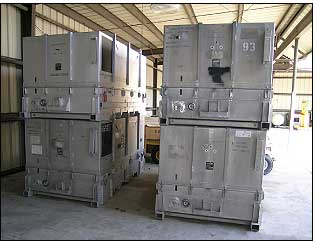Back in August 2002, members of the V-22 Fleet Support Team opened a large metal container holding a spare engine for the V-22 Osprey and found a pool of water inside. Some parts had visible corrosion, and the engine had to be taken out of storage and repaired at considerable expense. Nearly two years later, the Navy might have found an inexpensive way to monitor the condition of valuable spare parts in storage—an RFID sensor network.
Working with researchers at the Georgia Institute of Technology in Atlanta, the Navy has come up with an RFID system that doesn’t use RFID readers to scan each tag, but instead uses battery-powered tags that can pass information from one to another until the data reaches the last transponder, which communicates with a single reader.
“The U.S. military was spending a lot of money to track high-value assets in Europe,” says Gisele Bennett, associate professor of optics and photonics at Georgia Tech. “The problem was, you only knew where items were when they were near an interrogator. We started to look at [reducing the reader and wired network] infrastructure.”
Using commercially available components, the researchers developed an RFID sensor that measures temperature, humidity and air pressure and can communicate changes in conditions, via other sensors, to a central station. The tags have a two-year battery life and use very low power, which the military requires because high-power electromagnetic emissions can set off explosives.
There have been a lot of articles written lately about ad hoc sensor networks that configure themselves based on their position. The Navy system is different. Because the Navy wants to know which container has a problem and where it’s located, it was better to have network points, or nodes, linked together in a hierarchy and have each point mapped to a position.
The tags do not broadcast information unless they are interrogated by a base station, which sends out a security code. That saves battery life. It also prevents the tag from potentially alerting an enemy to the position of a ship at sea or allowing someone to get access to inventory information without authority.
The system was installed at a Marine Aviation Logistics Squadron at the Marine Corps Air Station in New River, N.C., in January ’04 and has been operational since the end of February. “It works great,” says Bill Sanford, a logistics management specialist with the V-22 Fleet Support Team. “We’re monitoring the pressure, humidity and temperature of four containers under a shelter and one in the sun. The system uploads six reports a day that I can review from my desk, and I would get an e-mail alert if there were a problem.”
If adopted, the system could help the Navy save a lot of money by ensuring that expensive parts aren’t damaged by environmental conditions. Another reason is the system reduces labor. Marines currently have to manually check the engine containers once every 28 days on land and at least once every 14 days when they are deployed aboard ship or other austere environments.
The V-22 Fleet Support Team spent about $150,000 on the pilot. The RFID sensors cost will be competitive in price with the DOD’s current tags on the RFID II Contract, which is about $100 each, excluding battery. But that’s because there are no commercial sensors available. If the Navy decides to deploy this system for monitoring containers, the sensors could be manufactured more cost-effectively.
The Marine Aviation Logistics Squadron will soon report the results of the pilot to the Navy Inventory Control Point—part of the Navy Supply Systems Command, which supplies the Navy—and Naval Air Systems Command, which oversees all aspects of Naval Aviation. A decision may hinge, to some degree, on the Department of Defense’s RFID requirements, expected to be published this month, for the tagging of equipment and supplies shipped to the military.
The DOD plans to use Electronic Product Code (EPC) technology, but specifications for battery-powered EPC tags that could be used with sensors haven’t been created. The DOD may be reluctant to deploy the sensor system until it can be sure it will be compatible with its EPC infrastructure.
“I hope the Navy rolls it out,” says Sanford. “We’re real pleased with the tests. The DOD specifications for using RFID will probably determine which way we go.”
Attend RFID Journal
University
There is less than one week left until RFID Journal University in Chicago. This unbiased educational course, presented by RFID Journal and members of Auto-ID Labs, is designed to provide the in-depth understanding of RFID and EPC technologies needed to evaluate vendors and begin planning a successful implementation. Register today, or to learn more, visit RFID U.


